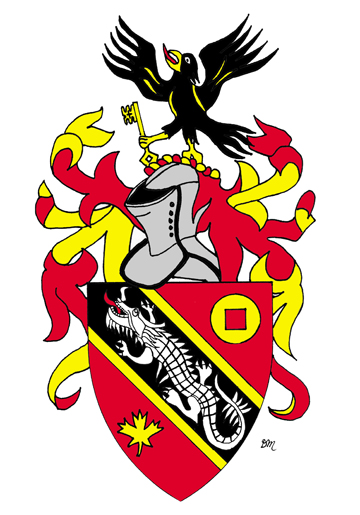
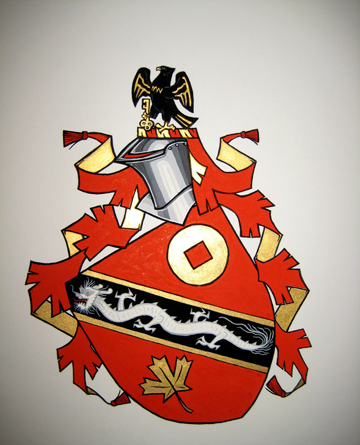
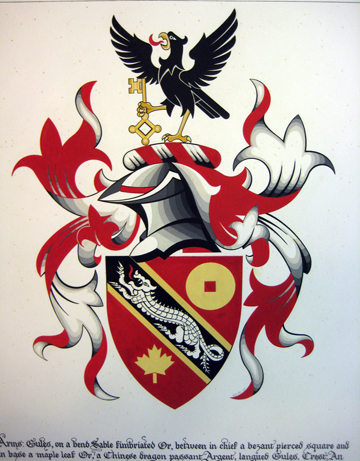
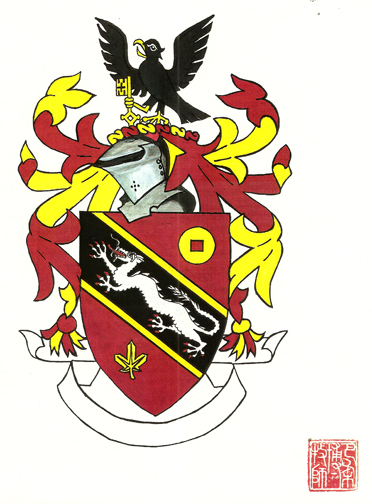
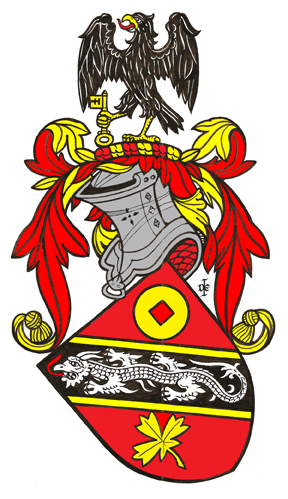
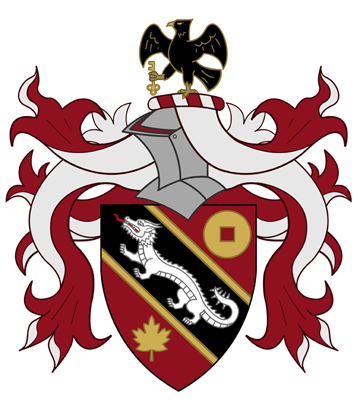
Coat of Arms of Derwin Mak
 |
 |
 |
 |
 |
 |
drawn by Derwin Mak |
painted by Kathryn Adams |
painted by the Bureau of Heraldry, South Africa |
painted by Dr. Robert Black, FRHSC |
drawn by Dennis Endean Ivall |
drawn by Tina Olah |
Visit The Chinese Armorial, a roll of arms of Chinese armigers.

Above: my drawing of my coat of arms
I have long been interested in heraldry, so I designed a coat of arms for myself in my university years. I assumed this coat of arms without a grant or registration from any government authority; in Canada, it is legal to do so (and still is, despite the existence of the Canadian Heraldic Authority. There is no law that actually requires a person to register or have his coat of arms granted by a government authority. There are, however, legal problems in using another person's coat of arms.).
My coat of arms was what heraldists call "assumed arms." In addition to assumed arms, there are arms granted by a heraldic authority such as the College of Arms in London, U.K. The College of Arms, acting on authority delegated by the British monarch, grants coats of arms as an honour from the British Crown to persons in Britain and the Commonwealth (except in Scotland, where the Court of the Lord Lyon has official jurisdiction over heraldic matters. The British still have a lot of Tudor-era offices and titles with complicated roles and responsibilities).
In 1988, the Queen issued Letters Patent to establish the Canadian Heraldic Authority (CHA) as part of the Canadian monarchy, not Britain's, reporting to the Governor General of Canada. Here was my chance to receive an honour from the Canadian Crown. I immediately applied to the Canadian Heraldic Authority to receive a grant of a coat of arms of my design. I would have become the first Chinese Canadian to receive a grant of arms from the Canadian Heraldic Authority had not David See-Chai Lam become Lieutenant Governor of British Columbia in 1988. His Honour took precedence, and I became the second Chinese Canadian to receive a coat of arms from the Canadian Heraldic Authority.
The blazon (official description in heraldic terminology of the coat of arms) is:
Arms: Gules, on a bend Sable fimbriated Or between in chief a bezant pierced square and in base a maple leaf Or a three clawed Chinese dragon passant Argent langued Gules.
Crest: Upon a helmet mantled Gules doubled Or on a wreath Or and Gules an Eagle rising Sable beaked armed and membered Or grasping in the dexter talon a Key ward upward dexter also Or.
The colours combine the traditional colours of China (red and gold), the German Empire of the nineteenth century (black, white, red), and Canada (red and white). The German Imperial colours and the black eagle are symbols of Germany, referring to my home town of Kitchener, Ontario, which was known as Berlin before World War I. The eagle holds a key, a medieval symbol of accountants. The "bezant pierced square" resembles an old Chinese coin, another symbol of my accounting profession. The symbolism of the Chinese dragon and maple leaf is obvious.
A heraldist joked that I had used the colours and animals of three great empires: China, Germany, and the Holy Roman Empire. However, Robert Watt, then the Chief Herald of Canada, didn't let my imperial pretensions get too far…
The Chief Herald explicitly blazoned the dragon to have three claws (that is, three toes per paw). In Chinese tradition, the Emperor uses a five-clawed dragon as a symbol, princes use a four-clawed dragon, and generals and high-ranking civil officials use a three-clawed dragon.
In contrast, the blazon of David Lam's coat of arms does not specify the number of claws on its dragon, and the painting on its Letters Patent shows an imperial five-clawed dragon because he was the representative of the Queen. However, his descendants, who inherited his coat of arms, might not become vice-regal representatives, and they'll still be able to use a coat of arms with a five-clawed dragon. Interestingly, in the slim chance that either I or my descendants (if any) become vice-regal representatives, we'll be stuck with a three-clawed dragon below our rank - unless the Canadian Heraldic Authority grants an honourary augmentation to my arms. This is where the rules of heraldry become quite complex, of interest only to nerdy types interested in such esoteric history.
Kathryn Adams painted the Canadian Heraldic Authority's illustration of my coat of arms.

Above: my coat of arms painted by Kathryn Adams for the Canadian Heraldic Authority
I also applied to South Africa's Bureau of Heraldry to register my coat of arms. South Africa has its own government heraldic authority that designs and registers coats of arms for people from around the world (These are registrations, though, not grants, which are considered an honour from the Crown). At the time, South Africa was still under the National Party, so I asked Frederick Brownell, State Herald of South Africa, if there were any rules preventing a Chinese Canadian from registering his coat of arms in South Africa. Brownell replied that South African heraldry is "colourful but colour blind. It is of absolutely no concern or interest to me what is a person's colour or creed is - only that they wish to become armigerous. Obviously, if a person wishes to include in his Arms a charge relevant to his cultural heritage, he is most welcome to do so. Indeed, such charges, blended with 800 years of tradition, serve only to enrich modern heraldry." What an enlightened view for that period of history.
The blazon used by the South African Bureau of Heraldry is:
Arms: Gules, on a bend Sable fimbriated Or, between in chief a bezant pierced square and in base a maple leaf Or, a Chinese dragon passant Argent, langued Gules.
Crest: An eagle rising, wings elevated and displayed Sable, armed and membered Or, grasping in the dexter claw a key erect of the last.
Wreath and mantling: Argent and Gules.
Note two subtle differences: in South Africa, my mantling (the slashed cloth covering the helmet) is red and white instead of red and gold; and more importantly, the number of claws on the dragon is not specified. Therefore, I could use a four-clawed dragon of a prince in South Africa if I wish. But I asked the State Herald of South Africa to draw my dragon with just three claws per paw.

Above: my coat of arms painted by the South African Bureau of Heraldry.
Other heraldists have painted or drawn my coat of arms. In heraldry, only the blazon is official. Heraldic artists are free to draw a coat of arms in their own style as long as the illustration conforms to the blazon.
Dr. Robert Black, an Anglican theology professor and Fellow of the Royal Heraldry Society of Canada, painted this illustration of my coat of arms, which he graciously gave to me as a gift. He drew the dragon with a princely four claws!

Above: my coat of arms painted by Dr. Robert Black, FRHSC
I registered my coat of arms with the American College of Heraldry, which is a non-governmental organization. Dennis Endean Ivall drew the illustration below for the American College of Heraldry's Heraldic Register of America:

Above: my coat of arms drawn by Dennis Endean Ivall
Science fiction and fantasy illustrator Tina Olah drew my coat of arms completely in Photoshop, without using any pencil, pen, or paper. She drew it according to the South African blazon, with red and white mantling and four claws on each paw of the dragon. I'm particularly impressed by the classically Chinese look of the dragon and her use of gold outlines on the Chinese coin and the maple leaf. She also used grey outlines on the features of the dragon, a technique also used by Kathryn Adams on her painting of my arms for the Canadian Heraldic Authority. As for Tina's style, I asked her to emulate the style of German heraldic artist Carl-Alexander von Volborth.

Above: my coat of arms drawn by Tina Olah.
In 2011, the Russian College of Heraldry informed me that Russian tradition entitled me to augment my coat of arms with supporters because I am an honourary military officer and member of an order of chivalry. In addition, some European heraldists told me that armigers could freely assume supporters in Germany, France, and Spain. On December 17, 2011, I assumed supporters for use while visiting the above countries.
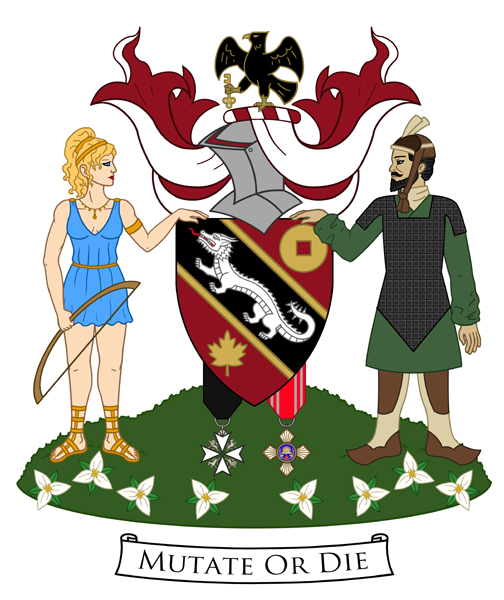 |
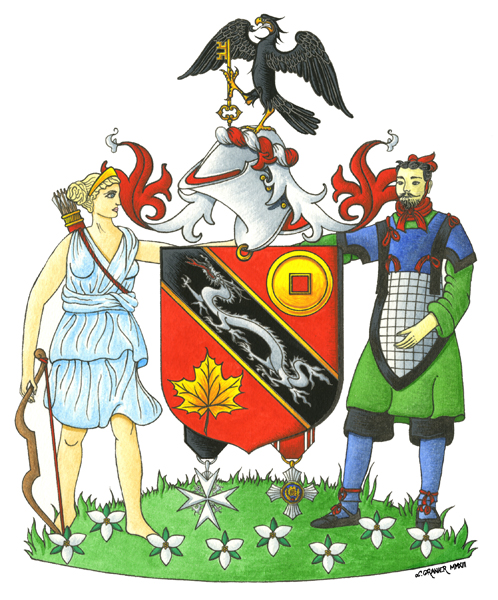 |
Coat of arms with supporters by Tina Olah |
Coat of arms with supporters by Laurent Granier |
The left supporter is the Goddess Diana holding a bow. Diana is goddess of the Moon and symbolizes my science fiction writing, especially my first novel, entitled The Moon Under Her Feet. The right supporter is a general of the Qin Dynasty and wears a uniform seen on officers of the famous terracotta army of the First Emperor. The General represents my interest in military and Chinese history. The two supporters stand on a grassy compartment with eight white trilliums, the symbol of Ontario.
I asked two artists to draw my coat of arms with supporters. Tina Olah drew it in Photoshop, again emulating the style of Carl-Alexander von Volborth. French heraldic artist Laurent Granier painted my coat of arms in gouache and watercolour on paper made from rags. His rendition of the Goddess Diana is based on a classical Greek statue.
I assumed the motto “MUTATE OR DIE” for my coat of arms on October 24, 2013. The motto is the title of an essay that I wrote for Enlightenment, the journal of the Doctor Who Information Network, in the 1987. The essay’s title was inspired by the title of the speech “Mutation or Death”, delivered by future science fiction editor Donald A. Wollheim for science fiction fan John B. Michel at the Third Eastern Science Fiction Convention in Philadelphia, October 1937. Despite the similarities of titles, my essay and Michel’s speech have nothing in common. I was condemning boorish behaviour at Doctor Who fan conventions, and Michel was advocating for left-wing political activism among science fiction fans.

Above: the Letters Patent of my coat of arms from the Canadian Heraldic Authority
Above: the Certificate of Registration of my coat of arms from the South African Bureau of Heraldry
In addition to my coat of arms, I also have a heraldic badge.
Grants and registrations of my coat of arms:
Library of Congress, U.S.A., copyright registration, certificate no. VAU 124-760, September 28, 1987.
Canadian Heraldic Authority, grant, The Public Register of Arms, Flags and Badges of Canada, Volume II, page 10, March 20, 1990.
Bureau of Heraldry (South Africa), registration, certificate 2148, February 9, 1990.
American College of Heraldry, registration number 893, The Heraldic Register of America, Volume Five, June 4, 1990.